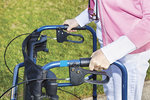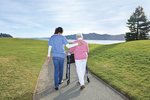

Fall prevention. At first blush, the topic doesn’t seem too exciting. After all, it’s just a trip or a tumble, right? What’s the big deal? But for those in the know, the topic is on the forefront of caring for seniors in our community.
“It’s huge,” says Greg Noelck, co-founder of the Healthy Aging Alliance of Clark County. “When we first formed the Healthy Aging Alliance, we actually called it the Fall Prevention Coalition. Preventing falls among people age 65 and older was our primary goal, but the name didn’t market well to our target audience, so we changed it to something more positive.”
Noelck, a physical therapist with PeaceHealth’s HomeCare Southwest who has spent nearly 20 years working with seniors recovering from fall-related traumas, says tracking the exact number of falls and fall-related injuries among seniors is tough. Often, seniors don’t report their falls, maybe out of a fear that their children will want to move them out of their home; and doctors don’t have a standardized system for tracking fall-related injuries. Still, there is some national data, Noelck says. And the numbers show the weight of the problem.
• In any 12-month period, one-third of people 65 and older will fall. For folks older than 80, that number goes up to one-half.
• U.S. healthcare costs related to falls (in 2013) were $34 billion.
• In 2013, the U.S. Centers for Disease Control (CDC) estimated that there were more than 734,000 hospitalizations due to people 65 and older falling.
• For the elderly, hip fractures – often the result of a fall – come with substantial risks:
According to figures Noelck has collected, among people over the age of 65 who suffer a hip fracture, 9 percent will die within 30 days. That number goes up to 17 percent if the person has a co-morbidity factor such as diabetes or high blood pressure; and up to a whopping 65 percent if the person also has congestive heart failure.
Noelck, along with his peers on the Healthy Aging Alliance of Clark County, have spent the past 18 months researching the topic of fall prevention and collecting best-practice methods for implementing a community wide approach to preventing falls amongst the county’s rapidly aging population.
Later this month, on Tues., April 21, Noelck will present a fall-prevention seminar to the Clark County Commission on Aging. There are a few, research-based practices that communities can implement to help prevent falls and fall-related injuries, Noelck says. Among these practices are:
Education – Community leaders can educate the general public on why falls occur and educate individual members of the senior community on the importance of reporting a fall and following up on necessary health care after a fall has occurred.
Vision – Having blurry vision, or being too near- or far-sighted can turn a simple trip down the staircase into a treacherous undertaking for many seniors.
“Encouraging seniors to get their vision checked regularly can make a big difference,” Noelck says.
Exercise – Noelck says seniors who get adequate amounts of physical, 30 minutes of exercise at least three times each week, are proven to fall less often than their peers who don’t incorporate physical activity into their daily routines.
There are some very specific exercise programs – Noelck recommends the SAIL program, which was developed in Washington State and focuses on stability and balance – that are known to help prevent falls. Another good one is the Tai Chi for Better Balance program, Noelck says.
Medication Reconciliation – Noelck says many prescription medications, particularly blood pressure meds, can actually contribute to falls. Often, seniors are taking two or three of these fall-inducing medications and don’t even realize it. Having a system in place to help educate seniors about these medications’ fall-related side effects – and to alert pharmacists when their customers are taking multiple medications linked to falls – is something that Noelck and other Healthy Aging Alliance members would love to see implemented in the longer term.
“The technology is there,” Noelck says. “But, of course, it take funding and time.”
Home Safety Modifications – Aging in place is popular and has multiple health benefits, if done correctly, but Noelck says many seniors are “aging in place” in unsafe, multiple-story homes. Having education and outreach programs in place on a community wide level would help.
“People need to start thinking about this earlier than they are,” Noelck says. “I think we should be reaching out to people in their 50s and 60s.”
Modifying a home before you actually need it can be a lifesaver if, or when, a health crisis occurs, Noelck says. Moving to a smaller, one-story home with wheelchair ramps and doors wide enough for walkers to navigate is ideal, but not feasible for many seniors. Instead, Noelck says, seniors can do little things, like installing rails on their front porch steps or putting a rail or seat in the shower.
For family members who want to help their aging loved ones understand the risks inherent in falling, Noelck recommends sitting down and coming up with a good plan.
“Really planning ahead is key,” Noelck says. “Have those home modifications in place before mom or dad falls and is injured.”
To find out more about the Healthy Aging Alliance and its fall-prevention work, visit http://healthyagingalliance.org/fall-prevention/. The Alliance members are all volunteer and meet on the first Tuesday of each month at the PeaceHealth HomeCare Southwest offices, 5400 MacArthur Ave., Vancouver.
The meetings are open to anyone interested in learning more about the Alliance and its work, as well as members of the community who are interested in joining the Alliance and promoting safe, active and healthy living for Clark County residents age 50 and older.